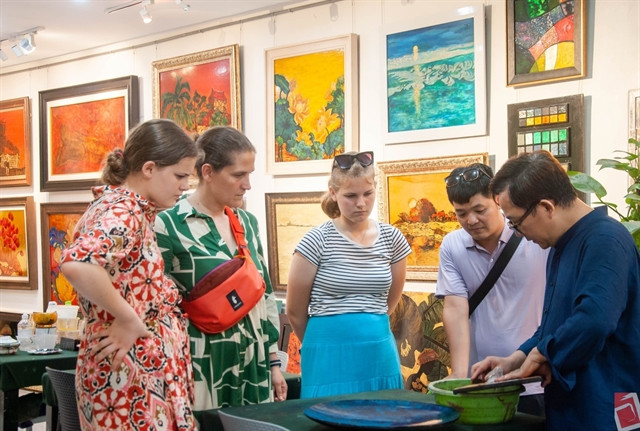The steps needed to create Vietnamese lacquerware will be introduced to South Africans during an event to promote Vietnamese culture in Pretoria.
Under the instruction of lacquer artisan Trần Anh Tuấn, who is also founder of the Lacquer School Tay Ho in Hà Nội, guests can perfect small lacquer items including jewelry and decorative objects.
 |
|
Deputy Director of the Cultural Diplomacy & UNESCO Affairs Department under the Ministry of Foreign Affairs, Hoàng Hữu Anh, speaks at a press conference about the “Việt Nam Days Abroad” event in Hà Nội. — Photo courtesy of Hoàng Mạnh Thắng |
The presentation is part of the “Việt Nam Days Abroad”
held by the Ministry of Foreign Affairs for the first time in South Africa in celebration of the 30th anniversary of Việt Nam – South Africa diplomatic relation.
Taking place in Pretoria on September 14 and 15, the event will feature the ‘Vietnamese Cultural Space’, where visitors can learn about the rich Vietnamese culture through interactive activities.
Alongside lacquer, visitors can also enjoy another interactive activity – to learn how to create Vietnamese Đông Hồ folk paintings. An artisan will show the guests how to use woodblocks to create a painting on poonah paper.
Traditional craft of tò he – small and colourful toy figurines that are made of rice dough, will also be presented to the visitors. They can try on the royal costumes of Nguyễn Dynasty (1802-1945) and explore Vietnamese cuisine.
 |
|
Lacquer artisan Trần Anh Tuấn (right) will show South African guests attending the “Việt Nam Days Abroad” in Pretoria, South Africa, how to make lacquerware. — Photo courtesy of Lacquer School Tay Ho |
Attendees will also have chance to learn more about Việt Nam through a photo exhibition showcasing vivid images of the country’s natural and cultural heritages that have been granted the UNESCO recognition.
Photographs presenting the diplomatic relation between Việt Nam and South Africa will also be on display at the ‘Vietnamese Cultural Space’ during the event.
An art show showcasing the distinctive culture of Việt Nam’s three regions – North, Central, South, is expected to win the applause of South African audience.
Nguyễn Yến, Director of Đông Đô Performance and Event Services – the show producer, has revealed that “the repertoire has been staged to connect with each other, aiming to tell a storyline called ‘Colour of Việt Nam’.”
“The ‘colours’ differentiate in each region and will be presented in the form of the UNESCO-recognised intangible heritages,” she said.
Yến said the show will be opened with a traditional dance of an ethnic Mông group from the northern mountainous region, followed by the lotus dance – a dance representing the Northern Delta region.
The show will include a showcase of the royal costumes of Nguyễn Dynasty “that represents the Centre”.
Traditional tunes and popular dances of the South will be presented.
Following the “Việt Nam Days Abroad” in South Africa, similar events will be held in France and Japan in November and December.
 |
|
The 3D design of the ‘Vietnamese Cultural Space’ in Pretoria, South Africa. — Photo courtesy of the organising committee |
At a press conference about the event in Hà Nội on Friday, Deputy Director of the Cultural Diplomacy & UNESCO Affairs Department under the Ministry of Foreign Affairs, Hoàng Hữu Anh said that the Việt Nam Days Abroad, as usual, consists of political, cultural and economic activities.
“This year, the organising committee has tailored the programme according to each country," he said.
"The programme aims at delivering a rich in culture yet dynamic Việt Nam to friends in South Africa, where we can further promote cultural exchange, and in Japan and France – the two nations that are ‘somewhat’ familiar to Vietnamese people,” he said.
“Việt Nam Days Abroad” is a national promotional event that the Prime Minister assigned the Ministry of Foreign Affairs to host annually since 2010. The event has been receiving enthusiastic participation of Vietnamese localities, enterprises, organisations, international communities and overseas Vietnamese communities. — VNS